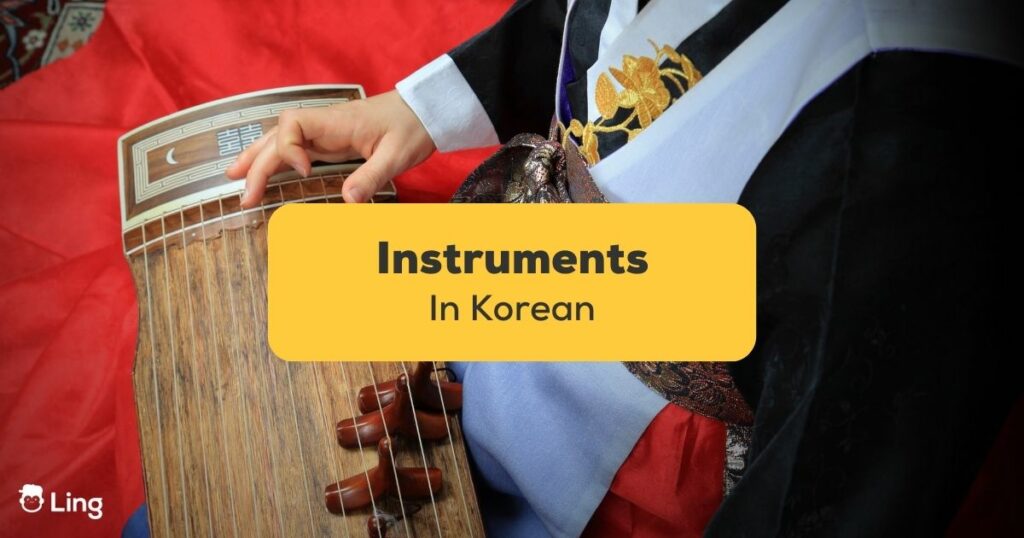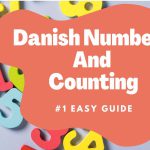One of the most beautiful things about Koreans is their rich culture, like their traditional music. Preserving traditional music from the past is a terrific method to connect the past with the present. It also serves as a wonderful reminder of Korea’s rich heritage for all Koreans.
With the traditional musical instruments of Korea, history will be preserved for future generations. In this blog, we will talk about 악기 (akgi) or instruments in Korean as well as the common instruments in the Korean language.
What Are The Traditional Korean Musical Instruments
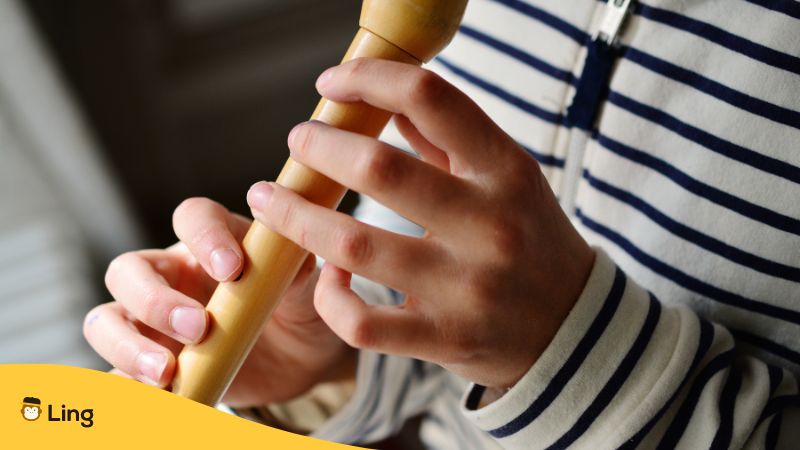
Wind Instruments
Most wind instruments in Korea are made out of bamboo. They are put into different groups based on how the musicians stand and which way the instruments face.
Piri 피리
The piri is a vertical instrument and a Korean double-reed instrument that is made of bamboo. Sound is created by blowing air into the bamboo cylinder pipe through the thin bamboo reed.
Danso 단소
The danso is one of the easiest instruments to identify since it resembles a flute. It is also a vertical instrument with a U-shaped mouth hole and five finger holes.
Saenghwang 생황
The saenghwang is a free-reed mouth instrument with a dried gourd wind chest. It is a free-reed mouth organ derived from the Chinese sheng but with distinct tuning. It is composed of 17 bamboo pipes, each with a free metal reed, set vertically within a wind chest.
Daegeum 대금
Dangeum is a horizontal wind instrument. The mouthpiece of the daegeum features a closed end and a membrane hole. The membrane is extracted from the interior of the reed stem and is responsible for its distinctive buzzing sound.
Other Wind Instruments
- Ji 지
- Tungso 퉁소
- Yak 약
- So 소
- Hun 훈
- Saenghwang 생황
- Nabal 나발
- Nagak 나각
- Taepyeongso 태평소
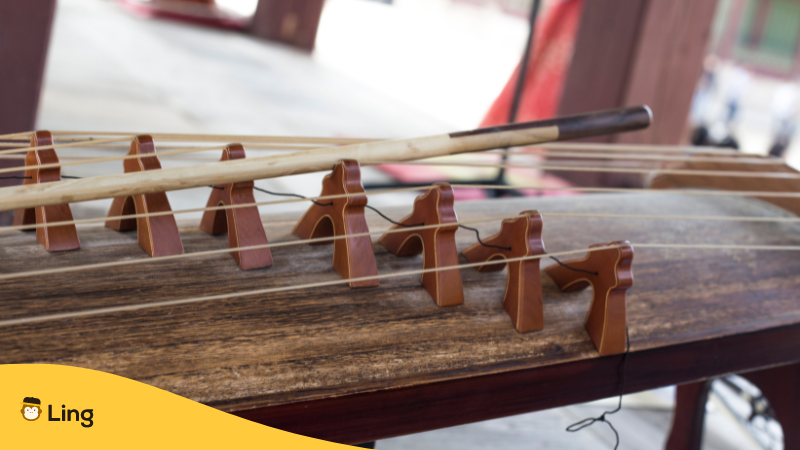
String Instruments
Paulownia wood and other materials are used to craft traditional Korean string instruments. They are classified according to the fundamental technique used to create the sounds, such as plucking, pulling, or striking.
Gayageum 가야금
The gayageum or kayagum most well-known Korean traditional musical instrument. It is a traditional Korean plucked zither with 12 strings; however, some contemporary variations have 18, 21, or 25 strings.
To create a sound, strings should be plucked and strummed. The soundboard, built of paulownia wood, features twelve adjustable bridges that support silk strings that are twisted. There are sanjo gayageum for traditional music, pungnyu gayageum for literati music, and modified gayageum for modern music or contemporary music. They come in a variety of materials, sizes, and string counts.
Haegeum 해금
This is also a very popular instrument in Korea today. The neck of the haegeum is like a stick. It has a hollow sound box made of wood and two silk strings and is held vertically on the knee of the performer. It looks like a vertical fiddle with two strings.
Ajaeng (아쟁)
The ajaeng is a zither bowed with a wooden stick. It has seven or eight strings that are twisted silk and are played with a thin stick made of forsythia wood or horsehair. The larger, seven-stringed daeajaeng is utilized for court orchestral music, whilst the eight-stringed soajaeng is employed for folk music or solo performances.
Yanggeum 양금
The yanggeum is played using a tiny bamboo stick to strike the metal strings. Four strings make up a string set, and fourteen string sets are positioned on two frets of a trapezoidal sound box.
Other String Instruments
- Geomungo 거문고
- Seul 슬
- Geum 금
- Ongnyugeum 옥류금
- Gonghu 공후
- Bipa 비파
- Wolgeum 월금
- Eoeungeum 어은금
- Haegeum 해금
- Sohaegeum 소해금
- Junghaegeum 중해금
- Daehaegeum 대해금
- Jeohaegeum 저해금
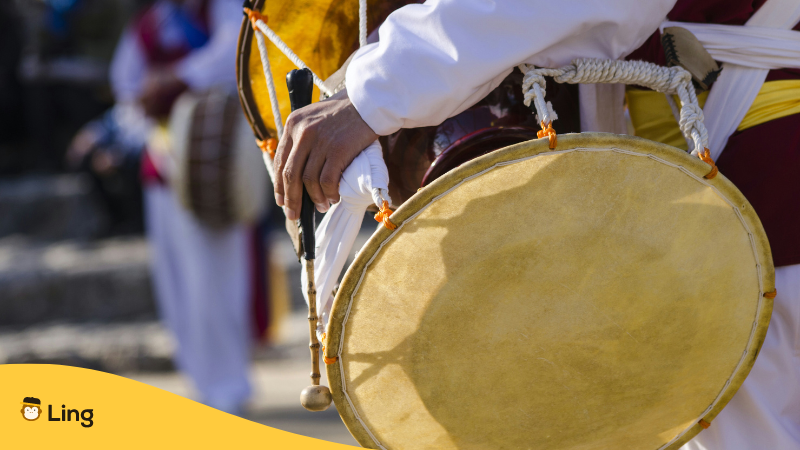
Percussion Instruments
One of the most interesting facts about Korean percussion instruments is that they are made with metal, animal skin, wood, bamboo, and stone. They are also separated into two categories: those with various pitches and those without pitches. The most frequently shown melodic percussive instruments are the pyeonjong and pyeonggyeong. Those instruments without pitches are bak, jwago, janggu, kkwenggwari, jing, and buk.
Bak 박
The bak is made of six pieces of hardwood that are bonded together at one end. When the boards are spread out, they look like a fan. The bak is played once when the music starts or when rhythmic patterns change in a big way.
Janggo Or Janggu 장고 or 장구
The janggu is a drum that looks like an hourglass and is made of animal skins and wood. For court or classical music, the janggu is played with one stick and one hand. For folk music and the janggu dance, two sticks are used.
Jwago 좌고
The jwago is a drum that hangs from a wooden frame. The person who plays it always sits on the ground. It is arranged in orchestra or wind ensembles in order to cue the first beat or to intensify the sound of the janggu.
Pyeongyeong 편경
The pyeongyeong is made up of 16 stones that are hung on a wooden frame. It is played with a cow horn stick. The pitch of each stone is different. The pitch goes up with the thickness of the stone.
Other Percussions Instruments
- Buk 북
- Jongn종
- Pyeonjong 편종
- Teukgjong 특종
- Teukgyeong 특경
- Banghyang 방향
- Ulla 운라
- Galgo 갈고
- Jingo 진고
- Geongo 건고
- Yonggo 용고
- Eunggo 응고
- Sakgo – 삭고
- Gyobanggo 교방고
Other Korean Musical Instruments
Gongs
- Kkwaenggwari 꽹과리
- Jing 징
Cymbals
- Jabara 자바라
Wooden instruments
- Bak 박
- Chuk 축
- Eo 어
Other Instruments In Korean
Learning Korean with music can be an interesting and fun journey. Take a look at the following music-related vocabulary to inmerse yourself more in the language.
| English | Korean | Romanization |
| Acoustic guitar | 어쿠스틱 기타 | eokuseutik gita |
| Accordion | 아코디언 | akodieon |
| Bassoon | 바순 | basun |
| Bass | 베이스 기타 | beiseu gita |
| Banjo | 밴조 | baenjo |
| Cymbal | 심벌즈 | simbeoljeu |
| Cello | 첼로 | chello |
| Clarinet | 클라리넷 | keullarinet |
| Drums | 드럼 | deureom |
| Electric guitar | 전기 기타 | jeongi gita |
| Flute | 플루트 | peulluteu |
| French horn | 프렌치 호른 | peurenchi horeun |
| Guitar | 기타 | gita |
| Harmonica | 하모니카 | hamonika |
| Harp | 하프 | hapeu |
| Harpsichord | 하프시코드 | hapeusikodeu |
| Keyboard | 전자식 건반 악기 | jeonjasik geonban akgi |
| Organ | 오르간 | oreugan |
| Oboe | 오보에 | oboe |
| Piano | 피아노 | piano |
| Piccolo | 피콜로 | pikollo |
| Recorder | 리코더 | rikodeo |
| Saxophone | 색소폰 | saeksopon |
| Tambourine | 탬버린 | taembeorin |
| Trombone | 트롬본 | teurombon |
| Trumpet | 트럼펫 | teureompet |
| Tuba | 튜바 | tyuba |
| Ukulele | 우쿨렐레 | ukullelle |
| Viola | 비올라 | biolla |
| Violin | 바이올린 | baiollin |
| Xylophone | 실로폰 | sillopon |

Looking For A Perfect Instrument For Language Learning?
For music lovers, enjoying music with the help of musical instruments is really a dream come true. But, for language learners, you also have a special instrument that will help them achieve their goals, like Ling app.
This app can be your solo instrument or a helpful tool for you to develop your language skills. With its advance and well-developed features, you’ll surely achieve your desired goals.
Download the app from Google Play or App Store and start learning Korean with Ling now!
